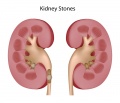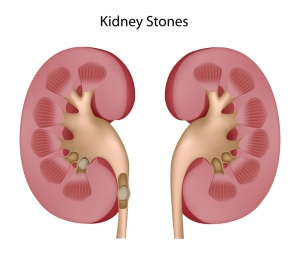Kidney Stones
A kidney stone, also known as renal calculi or nephrolithiasis is a solid mass made up of tiny crystals that form in the kidney from substances in the urine. The mass can reside in the kidney or in the ureter and can range in size from a small grain of sand to as large as a pearl.[1] Most kidney stones will pass on their own, but frequent or painful kidney stones require at look at the causal factors and supportive therapies.
|
Kidney Stones | |
| Causes | Dietary Factors, Stress, Heavy Metals, Infections |
|---|---|
| See Also | Urinary Conditions, Dehydration, Hyperuricemia, Vitamin D excess |
| Books | Books on Respiratory Conditions |
| Articles | Articles on Respiratory Conditions |
Naturopathic Assessment
Causal Factors
In order to stimulate the innate ability of the body to heal the causes of disease must be identified and addressed. With kidney stones the causes are variable and include lifestyle and environmental factors. A detailed assessment is required to determine which factors are contributing to renal stone formation.
Lifestyle
- Dietary Factors. The following dietary practices increase the risk of formation of calcium containing stones:[2]
- Low fiber intake
- High refined carbohydrate intake
- High alcohol consumption
- High consumption of animal protein
- High fat Intake
- High intake of calcium-containing food
- High intake of vitamin D-enriched food
- Low intake of Vitamin K
- Dehydration
- An Alkaline Diet may help to prevent and treat kidney stones composed of uric acid.[3]
- Diets low in oxalate can prevent the formation of kidney stones containing calcium oxalate.[2] Also calcium, protein, purines, sodium and ascorbic acid are known to be promoters of stone formation, whereas potassium and magnesium have been shown to be effective inhibitors.[4]
- Weight and Carbohydrate Metabolism
- Increased body weight and insulin insensitivity can lead to hypercalcuiruia and the risk of kidney stone formation.[5]
- Overweight and obesity are strongly associated with an elevated risk of stone formation in both genders due to an increased urinary excretion of promoters but not inhibitors of calcium oxalate stone formation. Overweight and obese men are more prone to stone formation than overweight women.[6]
Social
Environmental
- Kidney stones, known as struvite or infections stones, can develop as a result of urinary tract infections.[9]
- Bacteria appear to be associated with most forms of kidney stones.[10]
External
- Injury
- Kidney stones can develop as a result of injury or trauma to the body.
Medical Interventions
- Medical Procedures
- There seems to be an association between brushite stone disease and shock wave lithotripsy (SWL) treatment. Some have theorized that many brushite stone formers started as routine calcium oxalate (CaOx) stone formers who sustained an injury to the nephron which can lead to failure of urine acidification and eventual brushite stone formation.[11]
- Vasectomy produces anatomic, hormonal and immunologic changes and, although not substantiated by clinical studies, has been reputed to be associated with atherosclerosis, prostate cancer, testicular cancer and urolithiasis.[12]
- Medical Prescription
- Certain medications and over-the-counter products, such as antacids, can contribute to the formation of kidney stones.
Genetics
- Genetic Mutations
Diagnostic Testing
- The diagnosis of kidney stones is often based on the presenting symptoms.
- Kidney stones are often diagnosed based on routine abdominal or pelvic x-rays or ultrasounds.
- Lab tests include urinalysis, creatinine, kidney function test
- Other imaging may include computerized tomography (CT) scan or an intravenous pyelogram (IVP).
Related Symptoms and Conditions
Conditions related to Kidney Stones include:[2]
- Hyperparathyroidism
- Cystinuria
- Hyperuricemia
- Vitamin D excess
- Destructive Bone Disease
- Primary oxaluria
- Cushing Syndrome
- Sarcoidosis
Characteristics
Type of kidney stones include:[13]
- ~ 75% are calcium oxalate (phosphate) stones
- ~ 10 to 15% are struvite stones
- ~ 6% are uric acid stones
- ~ 2% are cystine stones
- other stones include carbonate apatite and brushite stones
- Oxalate Absorption - Individuals prone to kidney stone formulation have been found to have a tendency to absorb more oxalates.[2]
Common Symptoms
Kidney stones may present as asymptomatic and only be diagnosed adventitiously. When symptomatic, kidney stones may present with the following:[2]
- Excruciating intermittent lower back pain
- Hematuria (blood in the urine)
- Nausea
- Vomiting
- Abdominal Distention
- Fever and chills
- Polyuria
- Dysuria or burning pain when urinating
- Urine that smells bad or looks cloudy
- About 80% of all kidney stones are composed of calcium salts (75% calcium oxalate), while about 5% are pure uric acid. [14]
Naturopathic Treatment
The goal of naturopathic treatment is to support and work in tandem with the healing power of the body and to address the causal factors of disease with individual treatment strategies. Kidney stones are typically a chronic issue and require a thorough investigation to undercover the root cause. The recommended treatment strategy depends on the type and size of stone and the frequency of occurrence.
It is always advisable to work with a naturopathic doctor before engaging in any treatment plan.
Home Care
Home Care strategies include:
- Eliminate antacids.[15]
Lifestyle
Lifestyle recommendations include:
- Eliminate alcohol, caffeine and sugar.[15]
- Consume a diet that focuses on whole unprocessed food (whole grains, legumes, vegetables, nuts and seeds).[15]
- Nutritional intervention is based on a high water intake; decreased calcium and Vitamin C intake; as well as modest sodium and animal protein consumption. A low oxalate and low purine-diet is often advisable and can decrease the frequency of kidney stones.[14][16]
- Ensure you drink adequate water to help clear kidney stones and to prevent them from forming again. Drink at least 1/2 your body weight in ounces. You may need more liquids if you are physically active. The more physical activity you do, the more fluid your body needs. People with symptoms such as vomiting, diarrhea, and fever also need more fluids. Fluid needs also depend on air temperature, what you are wearing, and many other factors.
- Exercise is useful in weight management, and increase bodyweight along with decreased insulin sensitivity can increase the risk of recurrent stone formation.[2]
Naturopathic Therapies
Naturopathic Therapies for kidney stones include:
- Nutritional Foods include:[17]
- Fruits such as star fruit.
- Nuts and seeds such as walnut.
- Clinical Nutritional Supplementation includes
- Vitamins such as Vitamin B6, Vitamin K, Folic Acid,
- Minerals such as Magnesium, Calcium, Potassium Citrate
- Other supplements such as Flaxseed oil, Omega-3 Fatty Acids [15]
- Herbs such as Aloe (Aloe vera), Centaury (Centaurium erythraea), Yellow Dock (Rumex crispus), Common Madder (Rubia tinctorum), Fennel (Foeniculum vulgare), Alder Buckthorn (Rhamnus frangula), Partridge Berry (Mitchella repens), Knotgrass (Polygonum aviculare), Senna [2], Joe Pye Weed (Eupatorium Purpureum), Corn Silk (Zea mays), Smooth Hydrangea (Hydrangea arborescens)
- Gemmotherapies such as Fagus sylvatica
- Classical homeopathics: Hydrangea, Dioscorea, Berberis, Colocynthisis, Lycopodium [18]
- Complex homeopathics may be beneficial.
References
Reviewed by Iva Lloyd, BScH, RPE, ND [1]
- ↑ http://www.ncbi.nlm.nih.gov/pubmedhealth/PMH0001493/
- ↑ 2.0 2.1 2.2 2.3 2.4 2.5 2.6 2.7 Murray MT, Bongiorno PB. (2006) Pizzorno Textbook of Natural Medicine 3rd ed Chap 184 Kidney Stones Elsevier.
- ↑ Kessler T, Jansen B, Hesse A (2002) Effect of blackcurrant-,Cranberry- and plum-juice consumption on risk factors associated with kidney stone formation. Eur J Clin Nutr 2002; 56:1020-1023
- ↑ Siener R, Hesse A (Nov 2005) Recent advances in nutritional research on urolithiasis. World J Urol.;23(5):304-8. PMID: 16283326.
- ↑ Rao N, Gordon C, Davies D, et al. (1982) Are stone formers maladaptive to refined carbohydrates? Br J Urol 54:575-577
- ↑ Siener R, Glatz S, Nicolay C, Hesse A (Jan 2004) The role of overweight and obesity in calcium oxalate stone formation. Obes Res.;12(1):106-13. PMID: 14742848.
- ↑ Najem GR, Seebode JJ, Samady AJ, et al (1997) Stressful life events and risk of symptomatic kidney stones. Int J Epidemiol 26:1017-1023
- ↑ Scott R, Cunningham C, McLelland A, et al. (1982) The importance of cadmium as a factor in calcified upper urinary tract stone disease—a prospective 7-year study. Br J Urol 54:584-589
- ↑ Holmgren K, Danielson BG, Fellström B, Ljunghall S, Niklasson F, Wikström B (1989) The relation between urinary tract infections and stone composition in renal stone formers. Scand J Urol Nephrol.;23(2):131-6. PMID: 2667113.
- ↑ Tavichakorntrakool R, Prasongwattana V, Sungkeeree S, Saisud P, Sribenjalux P, Pimratana C, Bovornpadungkitti S, Sriboonlue P, Thongboonkerd V (Mar 2012) Extensive characterizations of bacteria isolated from catheterized urine and stone matrices in patients with nephrolithiasis. Nephrol Dial Transplant. PMID: 22461670.
- ↑ Krambeck AE, Handa SE, Evan AP, Lingeman JE (Aug 2010) Brushite stone disease as a consequence of lithotripsy? Urol Res.;38(4):293-9. PMID: 20623223.
- ↑ Raspa RF (Nov 1993) Complications of vasectomy. Am Fam Physician.;48(7):1264-8. PMID: 8237740
- ↑ Robbins Stanley, Cotran Ramzi, Kumar Vinay, Collins Tucker (1999) Pocket Companion to Robbins Patholoical Basis of Disease, 6th Edition W.B. Saunders.
- ↑ 14.0 14.1 Miggiano GA, Migneco MG. Diet and nutrition in nephrolitiasis Clin Ter 2007 Jan-Feb;Vol.158(1):49-54. PMID:17405659
- ↑ 15.0 15.1 15.2 15.3 Murray Michael 1996 Encyclopedia of Nutritional Supplements, The Essential Guide for Improving Your Health Naturally Prima Publishing
- ↑ Hochreiter W; Knoll T; Hess B (Feb 2003) Pathophysiology, diagnosis and conservative therapy of non-calcium kidney calculi Ther Umsch;60(2);89-97. PMID:12649987.
- ↑ Lu Henry (1986) Chinese System of Food Cures, prevention and remedies Sterling Publishing Co. New York.
- ↑ Hershoff A. (2000) Homeopathic Remedies, A Quick and Easy Guide to Common Disorders and their Homeopathic Treatments, Avery Publishing Group, New York

